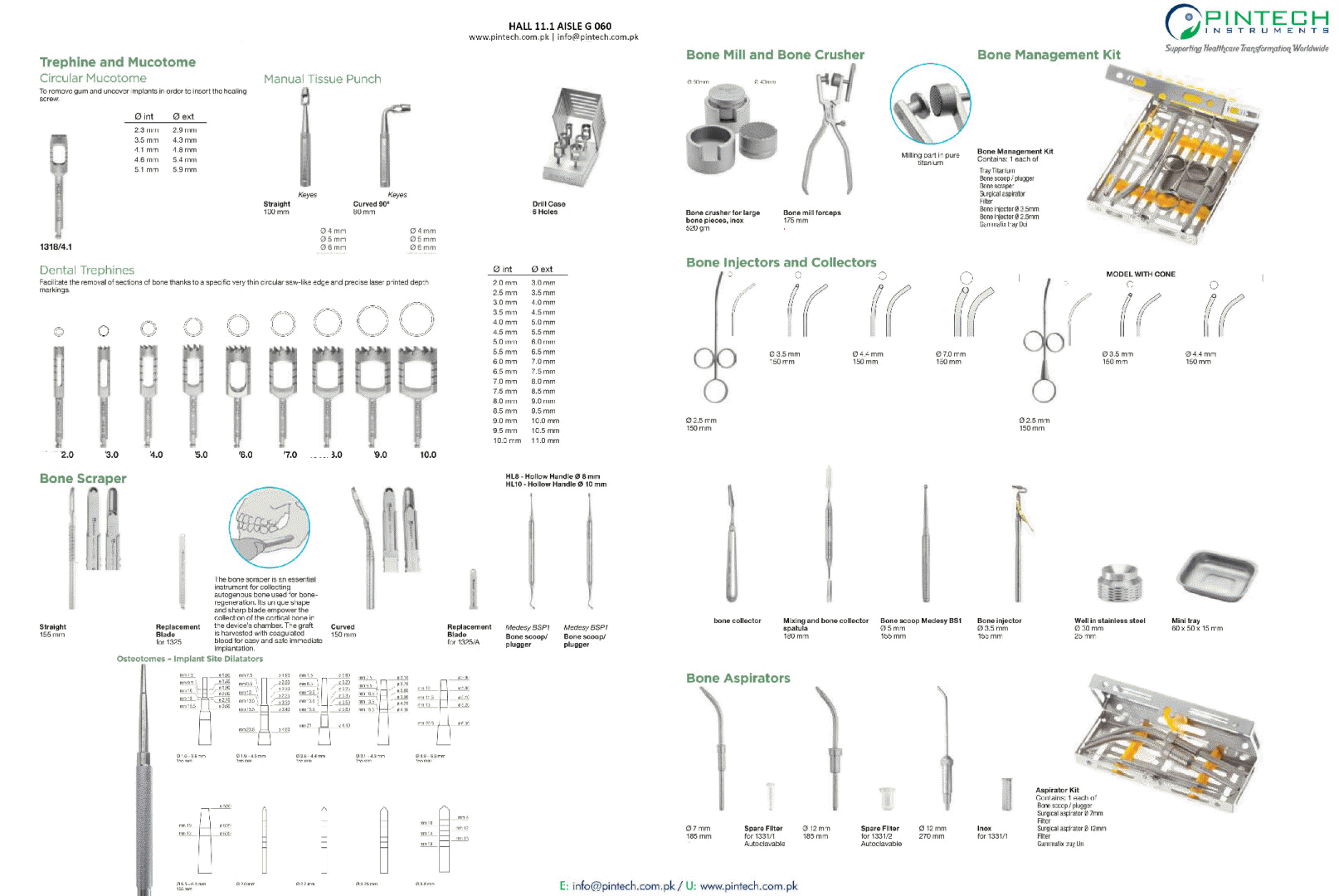Advertisement

1. Trephines:
Description: Cylindrical cutting instruments used to remove a core of bone or tissue. They are often used for biopsies, harvesting bone grafts, or preparing implant sites.
Types: Trephines are primarily differentiated by their diameter and cutting edge design (e.g., serrated, smooth).
2. Mucotomes:
Description: Instruments used to harvest connective tissue grafts, often from the palate. They are designed to create a precise incision and remove a strip of tissue while minimizing trauma.
Types: Mucotomes vary in blade shape, width, and angulation.
3. Bone Scrapers (Curettes):
Description: Used to scrape or remove bone tissue, often for smoothing bony surfaces, harvesting bone grafts, or removing granulation tissue.
Types: Bone scrapers come in a variety of shapes (e.g., curved, straight), sizes, and blade designs (e.g., serrated, smooth) to suit different applications. Common names include Lucas curette, Molt curette, etc.
4. Bone Mills and Crushers:
Description: These instruments are used to process harvested bone into smaller particles for grafting. Mills grind the bone, while crushers break it into smaller pieces.
Types: Mills and crushers can be manual or powered.
5. Bone Injectors:
Description: Used to deliver bone graft material to a specific site. They are particularly useful for confined spaces or when precise placement is needed.
Types: Bone injectors come in various sizes and designs, including syringe-type injectors and those with specialized tips for different grafting materials.
6. Bone Collectors:
Description: Devices used to collect bone fragments generated during drilling or other surgical procedures. This collected bone can then be processed and used for grafting.
Types: Bone collectors can be integrated with surgical handpieces or be separate devices. They vary in collection capacity and how they filter and process the bone.
Description: Cylindrical cutting instruments used to remove a core of bone or tissue. They are often used for biopsies, harvesting bone grafts, or preparing implant sites.
Types: Trephines are primarily differentiated by their diameter and cutting edge design (e.g., serrated, smooth).
2. Mucotomes:
Description: Instruments used to harvest connective tissue grafts, often from the palate. They are designed to create a precise incision and remove a strip of tissue while minimizing trauma.
Types: Mucotomes vary in blade shape, width, and angulation.
3. Bone Scrapers (Curettes):
Description: Used to scrape or remove bone tissue, often for smoothing bony surfaces, harvesting bone grafts, or removing granulation tissue.
Types: Bone scrapers come in a variety of shapes (e.g., curved, straight), sizes, and blade designs (e.g., serrated, smooth) to suit different applications. Common names include Lucas curette, Molt curette, etc.
4. Bone Mills and Crushers:
Description: These instruments are used to process harvested bone into smaller particles for grafting. Mills grind the bone, while crushers break it into smaller pieces.
Types: Mills and crushers can be manual or powered.
5. Bone Injectors:
Description: Used to deliver bone graft material to a specific site. They are particularly useful for confined spaces or when precise placement is needed.
Types: Bone injectors come in various sizes and designs, including syringe-type injectors and those with specialized tips for different grafting materials.
6. Bone Collectors:
Description: Devices used to collect bone fragments generated during drilling or other surgical procedures. This collected bone can then be processed and used for grafting.
Types: Bone collectors can be integrated with surgical handpieces or be separate devices. They vary in collection capacity and how they filter and process the bone.

291 Mohallah East Bhopalwala
51030 Sambrial
Pakistan
51030 Sambrial
Pakistan
more information
Hall 11.1 | G060

